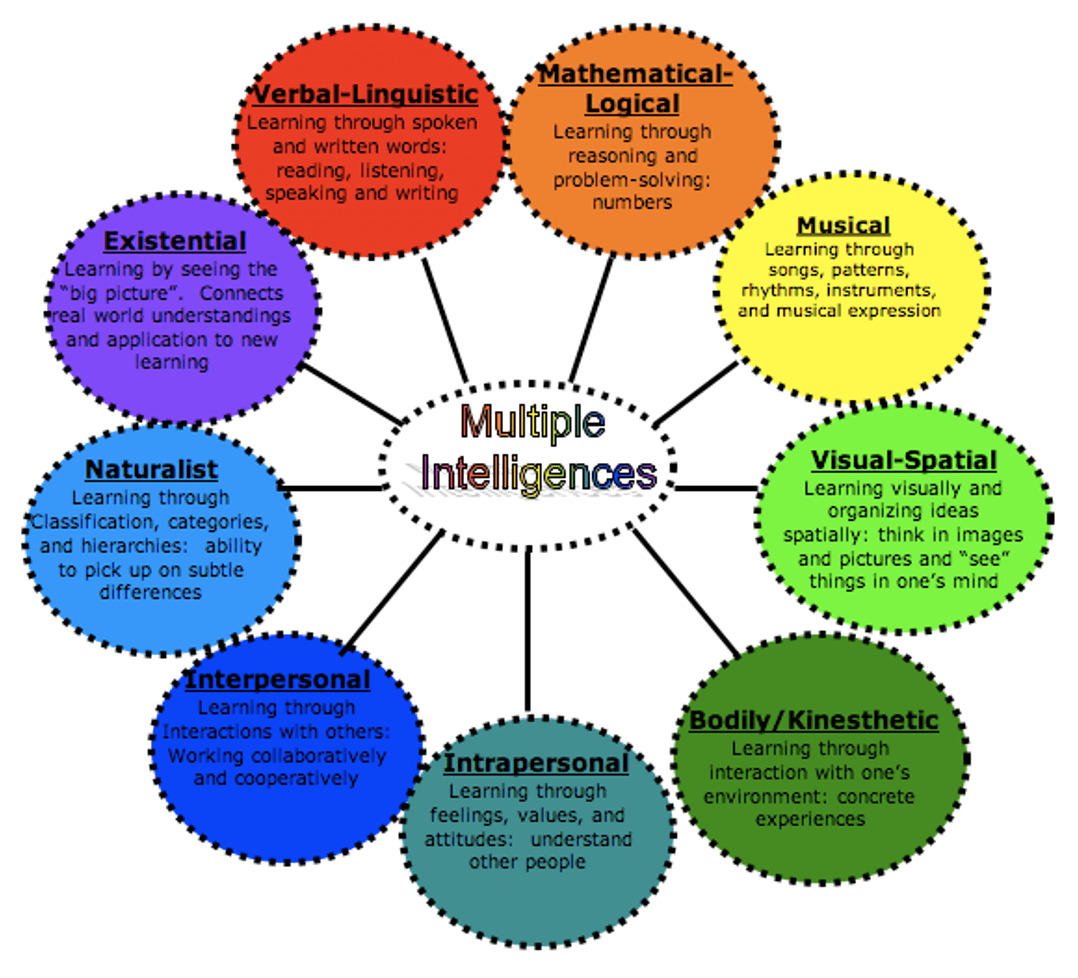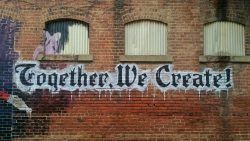Using Multiple Intelligences in Facilitation
Eliciting Creativity through Using Multiple Intellligences in Facilitation
Above is a graphic representation of nine intelligences identified by Howard Gardner, with a tiny summary of what each is about. There is controversy about whether these are “intelligences”, but they do provide insight into different ways that people process information.
Howard Gardner[1] at first identified seven intelligences (starting at 11 o’clock and moving clockwise in this image), and then broadened his work to include two more. He was careful to say that we are all intelligent, in ways beyond the two intelligences (Verbal-Linguistic and Mathematical-Logical) that we measure in IQ tests. He says that we are all stronger in some intelligences and weaker in others. We can use our stronger intelligences to learn and process information, and do exercises to strengthen our weaker ones.
I think of multiple intelligences as a paint palette from which to choose tools to help individuals in a group access their wisdom. I try to include at least 2-3 different intelligences in every facilitation so that everyone has some opportunity to use their stronger intelligences.
Kinesthetic Intelligence
Years ago, I had a participant in a facilitation training course who had to move his body in order to understand concepts. He sat at the back of the room and threw his arms around actively as he tried to take the concepts we were teaching and process them into visual and kinesthetic forms. He struggled with the concept of “gestalt” as we use it in the Consensus Workshop method, until I found a simple jigsaw puzzle to put together during the break and talk through the process while he did it. We talked about how unique ideas are like the puzzle pieces. When we cluster them, they connect with each other to create a bigger picture that is larger than the sum of the parts. Since he was moving and connecting the puzzle pieces until a larger picture emerged,, the concept fell into place for him. I learned from him a new way of explaining the clustering process, (the “puzzle story”) which I have used extensively since then.
Having the group stand up and do a tai chi or yoga exercise, or perhaps act out a topic, draws on kinesthetic intelligence for understanding and focusing.
Visual-Spatial Intelligence
One client I worked for was a teacher, who had for many years struggled in school until she discovered graphic recording. She could understand things best when she drew them, and she assumed that everyone’s mind worked best in this way. She encouraged me to do a consensus workshop in which every participant drew symbols on cards instead of writing out their ideas. Each person had to explain their symbol in words to make sure others understand what they were symbolizing, but it was a very engaging workshop.
Some of our methods, like the consensus workshop method and the historical scan / journey wall, have a visual aspect built into them, as the ideas are related to each other visually on the wall.
Once in a northern First Nation community, I had a gifted graphic facilitator working with me as a documentor. He added visuals to the words people said as they were doing a vision workshop, and later to the historical scan they had created. The community was delighted with the visuals, and they bridged the gap between the two languages that different people in the community used. Some graphic facilitators use visual language almost exclusively to hold the wisdom of a group.
Musical Intelligence
When I design and facilitate a process, I am aware that in the back of my mind, I am feeling the rhythm of the process, using musical intelligence. As I facilitate, I sense I am a conductor, not producing the sound myself but keeping the group on pace, drawing out the quieter voices and gently softening the louder voices, bringing harmony to the group as they work.
Intrapersonal and Interpersonal Intelligences
I create quiet time for individual brainstorming, honouring intrapersonal intelligence, and then provide time for small group and large group discussion, honouring inter-personal intelligence. The group benefits from intrapersonal thinking as well as the energy of interpersonal connections.
Nature intelligence
Nature intelligence is more challenging to use in a facilitation session. I believe the description above in the graphic misses the point. Indigenous people know that when you are in nature, there is a different kind of thinking that happens, as your mind adapts to the rhythms of nature. So to use this intelligence in facilitation, I encourage breaks outside when possible, such as a walk in the woods to think through a challenging topic. Or I put an interesting rock and a plant or a bunch of flowers as table décor. One of my colleagues, setting up the room for a group to deliberate about growing trees as windbreaks, put a tiny sapling on every table. Then we used nature metaphors to name the historical scan.
Verbal-Linguistic Intelligence
I use this intelligence often in facilitation, as most discussion is in words! Thinking, writing, speaking, listening are all aspects of verbal-linguistic intelligence. I encourage people to write in the language they are thinking in, and then translate it if necessary. One time a Dogrib-speaking group was struggling with naming the clusters in a workshop. The cards in the cluster were all in English. I asked them to name the cluster in Dogrib, and then translate it back into English. Suddenly it was easy to name the essence of the cluster, because Dogrib is much better than English in capturing big ideas. There are other sources about this.
Storytelling is another great use of verbal-linguistic intelligence. I used a storytelling technique with my extended family at a family reunion, where old and young people were paired and told each other family stories, which we recorded. There were all kinds of insights into what makes our family strong.
Mathematical-Logical Intelligence
Clustering uses mathematical-logical intelligence. The challenge I find in groups is to steer them away from simple logical sorting to seeing the logical (and intuitive) connections between individual ideas to create new, larger, meaningful ideas. I encourage pattern-seeking rather than theming.
Existential Intelligence
I think this is where “grounding” comes in, an ICA behaviour I have had a hard time describing. I often ask people for specific examples of abstractions. When a group is “refreshing” a mission statement, I often take the statement apart and, phrase by phrase, ask “Where have you seen this in real life?” or “Give an example of how we actually act out this purpose.”
Summary
Each person in the room contributes to the final result when more than one intelligence is used as a tool in any facilitated event.
[1] Gardner, Howard. Frames of Mind: The Theory of Multiple Intelligences. New York: Basic Books, 1983.





